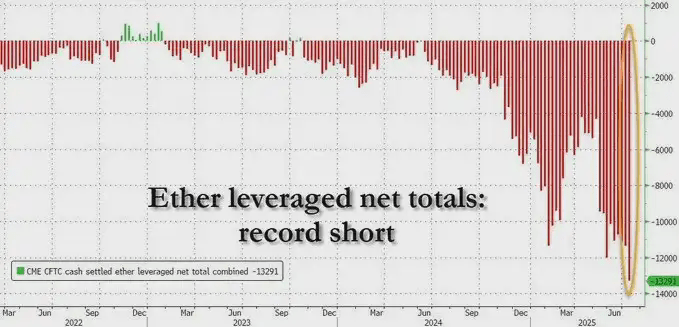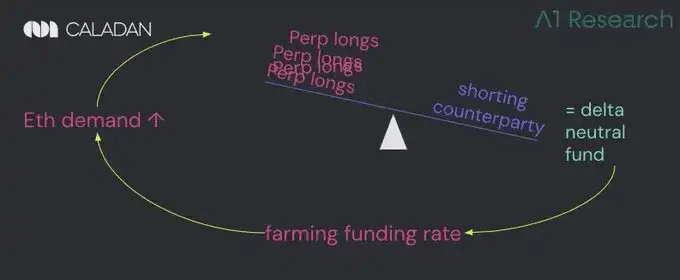The driving force behind the Ethereum derivatives market is not the consensus of a decentralized computer, but the structural harvesting of funding rate premiums.
Ethereum's price volatility seems simple: retail enthusiasm surges, prices soar, and market optimism continues to brew. But beneath the surface, there are structurally complex market mechanisms hidden. The funding rate market, the hedging operations of neutral strategy institutions, and recursive leverage demand intertwine, exposing the deep systemic fragility in the current crypto market.
We are witnessing a rare phenomenon: leverage has essentially turned into liquidity itself. The massive long positions taken by retail investors are fundamentally reshaping the way neutral capital allocation risk is configured, thereby giving rise to a new type of market fragility that most market participants have not yet fully recognized.
1. The phenomenon of retail following the trend to go long: when market behavior becomes highly convergent.
Retail demand is concentrated in Ethereum perpetual contracts because these leveraged products are easily accessible. Traders are flooding into leveraged long positions at a pace far exceeding the actual demand for spot purchases of Ethereum. The number of people wanting to bet on ETH's rise far exceeds the number of people actually buying Ethereum spot.
These positions need counterparties to take them on. However, as buying demand becomes unusually aggressive, short positions are increasingly absorbed by institutional players executing delta-neutral strategies. These are not directional bears, but funding rate harvesters who get involved not to short ETH, but to exploit structural imbalances for arbitrage.
In fact, this practice is not traditional shorting. These traders short perpetual contracts while holding an equivalent amount of spot or futures long positions. Although they do not bear ETH price risk, they earn returns from the funding rate premium paid by retail longs to maintain their leveraged positions.
With the evolution of the Ethereum ETF framework, this arbitrage trading may soon be enhanced through the layering of passive yield (staking returns embedded in the ETF wrapped structure), further strengthening the attractiveness of delta-neutral strategies.
This is indeed a brilliant trade, provided you can handle its complexity.

Delta-neutral hedging strategy: a response mechanism for legal 'money printing.'
Traders short ETH perpetual contracts to accommodate retail long demand, while hedging with spot long positions, thus converting the structural imbalance caused by persistent funding rate demand into profits.
In a bull market, funding rates turn positive, at which point longs must pay fees to shorts. Institutions employing neutral strategies earn returns by providing liquidity while hedging risks, thereby forming profitable arbitrage operations that attract continuous institutional capital inflow.
However, this gives rise to a dangerous illusion: the market appears deep enough and stable, but this 'liquidity' depends on a favorable funding environment.
The moment the incentive mechanism disappears, the structure it supports will collapse. The superficial market depth instantly turns into void, and as the market framework collapses, prices may oscillate violently.
This dynamic is not limited to crypto-native platforms. Even at the institution-dominated Chicago Mercantile Exchange, most short flows are not directional bets. Professional traders short CME futures because their investment strategies prohibit opening spot exposures.
Options market makers hedge delta through futures to improve margin efficiency. Institutions are responsible for hedging institutional client order flow. These are structural necessary trades, not reflections of bearish expectations. Open interest may rise, but this rarely conveys market consensus.
Asymmetric risk structure: why it is actually unfair.
Retail longs face direct risks of liquidation when prices move unfavorably, whereas delta-neutral shorts typically have more robust capital and are managed by professional teams.
They collateralize the ETH they hold as collateral, enabling them to short perpetual contracts in a fully hedged, capital-efficient mechanism. This structure can safely bear moderate leverage without triggering liquidation.
There are structural differences between the two. Institutional shorts have enduring resilience and sound risk management systems to withstand volatility; while leveraged retail longs have weak capacities and lack risk control tools, their operational tolerance for error is almost zero.
When market conditions shift, longs quickly disintegrate while shorts remain solid. This imbalance can trigger a seemingly sudden but structurally inevitable liquidation waterfall.
Recursive feedback loop: when market behavior becomes self-interfering.

The demand for longs in Ethereum perpetual contracts persists, requiring delta-neutral strategy traders to act as counterparties for short hedging, which keeps funding rate premiums consistently present. Various protocols and yield products compete to chase these premiums, driving more capital back into this cyclical system.
An ever-turning money-making machine does not exist in reality.
This will continue to create upward pressure, but it entirely depends on one prerequisite: longs must be willing to bear the cost of leverage.
The funding rate mechanism has an upper limit. In most exchanges (like Binance), the upper limit for the funding rate of perpetual contracts is 0.01% every 8 hours, equivalent to an annualized return of about 10.5%. When this limit is reached, even if long demand continues to grow, shorts seeking profits will no longer be incentivized to open positions.
Risk accumulation reaches a critical point: arbitrage profits are fixed, but structural risks continue to grow. When this critical point is reached, the market is likely to rapidly liquidate.
Why is ETH dropping harder than BTC? The narrative conflict of dual ecosystems.
Bitcoin is benefiting from non-leveraged buying driven by corporate fiscal strategies, while the BTC derivatives market has stronger liquidity. Ethereum perpetual contracts are deeply integrated into yield strategies and DeFi protocol ecosystems, with ETH collateral continuously flowing into structured products like Ethena and Pendle, providing yield returns for users participating in funding rate arbitrage.
Bitcoin is generally considered to be driven by natural spot demand from ETFs and corporations. However, a significant portion of ETF capital flows is actually the result of mechanical hedging: traditional financial basis traders buy ETF shares while shorting CME futures contracts to lock in a fixed price spread between spot and futures for arbitrage.
This is essentially the same as delta-neutral basis trading in ETH, except it is executed through a regulated wrapped structure and financed at a dollar cost of 4-5%. In this view, ETH's leveraged operations become yield infrastructure, while BTC's leverage forms structured arbitrage. Both are non-directional operations aimed at generating returns.
Cyclical dependency issue: when the music stops.
Here’s a question that might keep you awake at night: this dynamic mechanism has an inherent cyclical nature. The profitability of delta-neutral strategies relies on a continuously positive funding rate, which requires sustained retail demand and a prolonged bull market environment.
Funding rate premiums do not exist permanently; they are very fragile. When premiums shrink, a wave of liquidations begins. If retail enthusiasm wanes and funding rates turn negative, it means that shorts will pay fees to longs instead of collecting premiums.
When large-scale capital flows in, this dynamic mechanism can create multiple vulnerabilities. First, as more capital flows into delta-neutral strategies, the basis will continuously compress. Financing rates decline, and the profitability of arbitrage trades also decreases.
If demand reverses or liquidity dries up, perpetual contracts may enter a discount state, meaning the contract price is below the spot price. This phenomenon will hinder new delta-neutral positions from entering and may force existing institutions to close their positions. Meanwhile, leveraged longs lack margin buffer space, and even a mild market correction can trigger a chain of liquidations.
When neutral traders withdraw liquidity, long forced liquidations emerge like a waterfall, creating a liquidity vacuum where there are no genuine directional buyers below the price, only structural sellers. The originally stable arbitrage ecosystem quickly flips, evolving into a chaotic liquidation wave.
Misreading market signals: The illusion of balance.
Market participants often misinterpret hedging capital flows as bearish tendencies. In reality, high short positions in ETH often reflect profitable basis trades rather than directional expectations.
In many cases, what appears to be a strong derivatives market depth is actually supported by temporary liquidity provided by neutral trading desks, which harvest profits through funding premiums.
While the inflow of funds into spot ETFs can generate a certain degree of natural demand, the vast majority of trades in the perpetual contract market are essentially structurally artificial operations.
Ethereum's liquidity is not rooted in belief in its future; it exists as long as the funding environment is profitable. Once profits dissipate, liquidity will also fade.
Conclusion
The market can remain active for a long time under structural liquidity support, creating a false sense of security. But when conditions reverse and longs cannot maintain their financing obligations, a collapse can occur in an instant. One side is completely crushed while the other side withdraws calmly.
For market participants, recognizing these patterns means both opportunity and risk. Institutions can profit by understanding funding conditions, while retail investors should distinguish between artificial depth and real depth.
The driving force behind the Ethereum derivatives market is not the consensus of a decentralized computer, but the structural harvesting of funding rate premiums. As long as funding rates maintain positive returns, the entire system can operate smoothly. However, when the situation reverses, people will ultimately realize: the seemingly balanced appearance is merely a carefully disguised leveraged game.
#比特币巨鲸动向 #山寨季何时到来? #特朗普施压鲍威尔
$BTC $XRP $SOL


